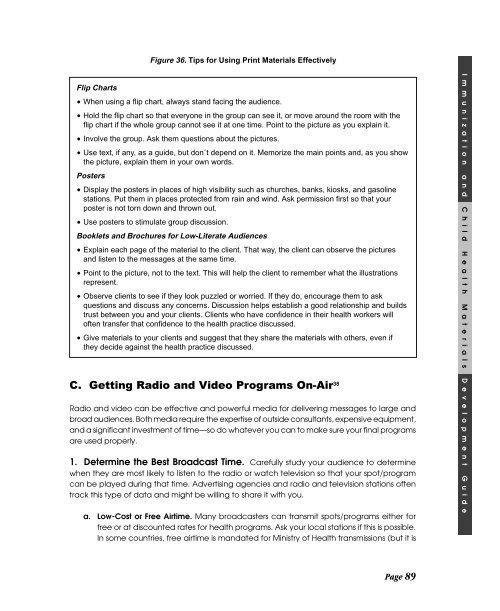Immunization and child health materials development guide pdf
Immunization and child health materials development guide pdf
Immunization and child health materials development guide pdf
Create successful ePaper yourself
Turn your PDF publications into a flip-book with our unique Google optimized e-Paper software.
Figure 36. Tips for Using Print Materials Effectively<br />
Flip Charts<br />
• When using a flip chart, always st<strong>and</strong> facing the audience.<br />
• Hold the flip chart so that everyone in the group can see it, or move around the room with the<br />
flip chart if the whole group cannot see it at one time. Point to the picture as you explain it.<br />
• Involve the group. Ask them questions about the pictures.<br />
• Use text, if any, as a <strong>guide</strong>, but don’t depend on it. Memorize the main points <strong>and</strong>, as you show<br />
the picture, explain them in your own words.<br />
Posters<br />
• Display the posters in places of high visibility such as churches, banks, kiosks, <strong>and</strong> gasoline<br />
stations. Put them in places protected from rain <strong>and</strong> wind. Ask permission first so that your<br />
poster is not torn down <strong>and</strong> thrown out.<br />
• Use posters to stimulate group discussion.<br />
Booklets <strong>and</strong> Brochures for Low-Literate Audiences<br />
• Explain each page of the material to the client. That way, the client can observe the pictures<br />
<strong>and</strong> listen to the messages at the same time.<br />
• Point to the picture, not to the text. This will help the client to remember what the illustrations<br />
represent.<br />
• Observe clients to see if they look puzzled or worried. If they do, encourage them to ask<br />
questions <strong>and</strong> discuss any concerns. Discussion helps establish a good relationship <strong>and</strong> builds<br />
trust between you <strong>and</strong> your clients. Clients who have confidence in their <strong>health</strong> workers will<br />
often transfer that confidence to the <strong>health</strong> practice discussed.<br />
• Give <strong>materials</strong> to your clients <strong>and</strong> suggest that they share the <strong>materials</strong> with others, even if<br />
they decide against the <strong>health</strong> practice discussed.<br />
C. Getting Radio <strong>and</strong> Video Programs On-Air 38<br />
Radio <strong>and</strong> video can be effective <strong>and</strong> powerful media for delivering messages to large <strong>and</strong><br />
broad audiences. Both media require the expertise of outside consultants, expensive equipment,<br />
<strong>and</strong> a significant investment of time—so do whatever you can to make sure your final programs<br />
are used properly.<br />
1. Determine the Best Broadcast Time. Carefully study your audience to determine<br />
when they are most likely to listen to the radio or watch television so that your spot/program<br />
can be played during that time. Advertising agencies <strong>and</strong> radio <strong>and</strong> television stations often<br />
track this type of data <strong>and</strong> might be willing to share it with you.<br />
a. Low-Cost or Free Airtime. Many broadcasters can transmit spots/programs either for<br />
free or at discounted rates for <strong>health</strong> programs. Ask your local stations if this is possible.<br />
In some countries, free airtime is m<strong>and</strong>ated for Ministry of Health transmissions (but it is<br />
Page 89

















